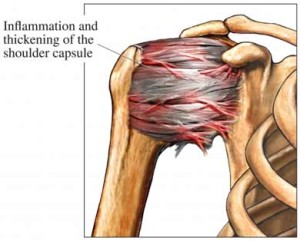Adhesive Capsulitis (Frozen Shoulder)
Global loss of shoulder motion can be a sign of adhesive capsulitis or frozen shoulder. Two main categories of this diagnosis are primary and secondary frozen shoulder.
 Primary adhesive capsulitis generally has an insidious onset. Three stages are typically involved: gradual loss of motion with increased pain (freezing), significant loss of motion with little pain (frozen) and finally a gradual return of functional motion (thawing). Primary adhesive capsulitis is idiopathic in nature, but there are certain factors, such as diabetes, hypothyroidism and underlying cardiopulmonary involvement that may predispose a person to a frozen shoulder.
Primary adhesive capsulitis generally has an insidious onset. Three stages are typically involved: gradual loss of motion with increased pain (freezing), significant loss of motion with little pain (frozen) and finally a gradual return of functional motion (thawing). Primary adhesive capsulitis is idiopathic in nature, but there are certain factors, such as diabetes, hypothyroidism and underlying cardiopulmonary involvement that may predispose a person to a frozen shoulder.
Secondary adhesive capsulitis is typically associated with immobilization after trauma (injury, disease or surgery) or unintentional guarding of movement resulting in loss of motion. Trauma related frozen shoulder generally presents with loss of motion in one specific direction while primary frozen shoulder will present with a global loss in all directions.
Treatment will depend on the category and your doctor can provide a proper diagnosis and discuss appropriate management. Physical therapy plays a vital role in patients diagnosed with adhesive capsulitis by providing interventions aimed at regaining functional range of motion. Physical therapy will include postural retraining; manual (hands-on) therapy to encourage the shoulder blade and arm bone to move independently, strengthening of the shoulder blade musculature and a gradual return to sports.
